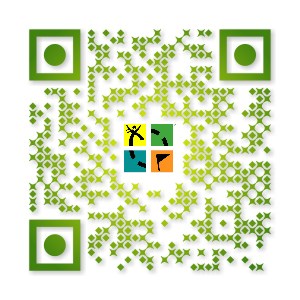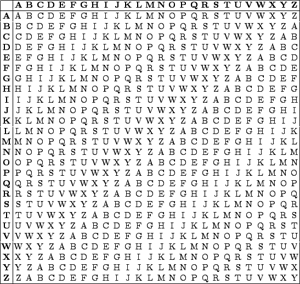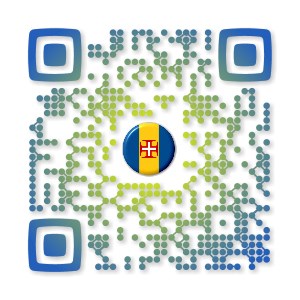
Lição 4: Criptografia
A complexidade dos criptogramas é variada. O Geocaching.com usa um criptograma simples para encriptar a(s) dica(s) por isso é relativamente fácil a sua desencriptar. É conhecida como ROT-13 ou criptografia Caesar com deslocamento de 13.
Se tiveres entre mãos um criptograma, o primeiro passo é determinar que criptograma está presente.
Códigos
O código, que é provavelmente o mais familiar para as pessoas é o código de barras. Há um em praticamente tudo o que compramos. Embora os códigos de barras utilizados pela indústria só pode conter números de 0 a 9. Enquanto outros códigos de barras que existem podem mostrar o que quisermos.

Substituição mono alfabética
Este tipo de criptograma passa por substituir cada letra do alfabeto por outra ou por um símbolo. Por exemplo:
THE COORDINATES ARE NORTH FORTY DEGREES ZERO POINT FIVE THREE TWO
WEST SEVENTY FIVE DEGREES TWO POINT FIVE ZERO TWO
podem ser encriptadas da seguinte forma:
Caesar com deslocamento de 3: (A=D, B=E, C=F, D=G, etc)
WKH FRRUGLQDWHV DUH QRUWK IRUWB GHJUHHV CHUR SRLQW ILYH WKUHH WZR
ZHVW VHYHQWB ILYH GHJUHHV WZR SRLQW ILYH CHUR WZR
Caesar com deslocamento de 6: (A=G, B=H, C=I, D=J, etc)
ZNK IUUXJOTGZKY GXK TUXZN LUXZE JKMXKKY FKXU VUOTZ LOBK ZNXKK ZCU
CKYZ YKBKTZE LOBK JKMXKKY ZCU VUOTZ LOBK FKXU ZCU
Atbash, alfabeto invertido: (A=Z, B=Y, C=X, D=W, …)
GSV XLLIWRMZGVH ZIV MLIGS ULIGB WVTIVVH AVIL KLRMG UREV GSIVV GDL
DVHG HVEVMGB UREV WVTIVVH GDL KLRMG UREV AVIL GDL
Criptogramas com palavra chave são mais complicados. Usam uma palavra ou frase secreta que omite qual a letra que decifra a outra letra. Por exemplo, se a frase secreta for LETS GO GEOCACHING, a desencriptação seria:
ABCDEFGHIJKLMNOPQRSTUVWXYZ
LETSGOCAHINBDFJKMPQRUVWXYZ
Na frase mudar a palavra “Geocaching” para “cahin” de forma a remove duplicação de letras. O resultado seria:
RAG TJJPSHFLRGQ LPG FJPRA OJPRY SGCPGGQ ZGPJ KJHFR OHVG RAPGG RWJ
WGQR QGVGFRY OHVG SGCPGGQ RWJ KJHFR OHVG ZGPJ RWJ
The PigPen ou Masonic cipher é fácil. Usa a "tradução" de uma letra por um símbolo:

da qual o resultado será:

Criptograma poli-alfabético
Na substituição poli-alfabética a letra A pode ser desencriptada uma vez como C e em outra vez como um T.
O criptograma Vigenère é conhecida por usar uma palavra ou frase com a “tabula recta”:

Usar esta tabela é relativamente fácil. Para codificar, define a mensagem e a palavra / frase chave em linhas separadas (como demonstrado abaixo). A palavra / frase chave repete-se até ao fim até ter o mesmo número de caracteres da mensagem. Depois, começando no "T" e no "L" à que encontrar a letra que corresponde na tabela. Localizando o "T" na horizontal e o "L" na vertical na tabela, a letra de intersecção é o "E".
THE COORDINATES ARE NORTH FORTY DEGREES ZERO POINT FIVE THREE TWO WEST SEVENTY FIVE DEGREES TWO POINT FIVE ZERO TWO
LET SGOGEOCACHI NGL ETSGO GEOCA CHINGLE TSGO GEOCA CHIN GLETS GOG EOCA CHINGLE TSGO GEOCACH ING LETSG OGEO CACH ING
ELX UUCXHWPAVLA NXP RHJZV LSFVY FLOEKPW SWXC VSWPT HPDR ZSVXW ZKU ASUT ULDRTEC YABS JIUTEGZ BJU ASBFZ TOZS BETV BJU
THE COORDINATES ARE NORTH FORTY DEGREES ZERO POINT FIVE THREE TWO WEST SEVENTY FIVE DEGREES TWO POINT FIVE ZERO TWO
Descodificar é um pouco diferente. Começando com o "L" e o "E", à que encontrar o "L" na vertical e o "E" na vertical. Depois de encontrado, a letra que intersecta é o "T".
Criptograma Poli-gráfico
Os criptogramas poli-gráficos como o Playfair, e o Trifid são ainda mais complicados. Codificam duas ou mais letras ao mesmo tempo usando uma palavra / frase chave. Normalmente usam dois tuplos de letras.
Criptograma de Transposição
Um criptograma de transposição muda a posição das letras de maneira a tornar-se uma mensagem codificada. Supondo o seguinte:
EIGHTFOURSEVEN
Uma forma de codificar a mensagem seria dividir o texto por três linhas, como por exemplo:
EIGHT
FOURS
EVENX
Agora lê de forma descendente cada coluna para codificar a mensagem:
EFEIOVGUEHRNTSX
Outros padrões incluem espirais, alternar linhas da esquerda com a da direita ou vice-versa, etc...
Criptograma Book (livro)
Um criptograma baseado em livro usa o tamanho de uma frase do livro como chave de encriptação. É comum usar-se dicionários, bíblias, documentos, etc...
Este tipo de criptograma encripta cada letra da mensagem por uma palavra / frase do livro em questão. Um triplete de números pode indiciar que seja o número da página, a linha e a palavra dessa linha.

Lesson 4: Cryptography
Introduction
There are many different types of ciphers from the simple to complex. Geocaching.com even uses a simple cipher for encrypting cache hints so that it is relatively easy to decode in the field. It is known as ROT-13 or the Caesar cipher with a shift of 13.
If you have a cipher on your hands, the first thing to do is determine what cipher you are dealing with. Most ciphers you will encounter on cache pages will be for letters only, so you will be deciphering into words.
Codes
The code that is probably most familiar to people is the barcode--there's one on just about everything we buy. Although barcodes used in the retail industry can only contain the number 0 through 9, there are many other barcodes out there that can display just about anything you want.

Monoalphabetic Substitution Cipher
A substitution cipher is very simple – replace every letter of the alphabet with some other letter or symbol. The key to this cipher is the mapping of one set of letters to another. For example:
THE COORDINATES ARE NORTH FORTY DEGREES ZERO POINT FIVE THREE TWO
WEST SEVENTY FIVE DEGREES TWO POINT FIVE ZERO TWO
can be encoded into a variety of somewhat simple forms using monoalphabetic substitution ciphers:
Caesar with a shift of 3: (A=D, B=E, C=F, D=G, and so on)
WKH FRRUGLQDWHV DUH QRUWK IRUWB GHJUHHV CHUR SRLQW ILYH WKUHH WZR
ZHVW VHYHQWB ILYH GHJUHHV WZR SRLQW ILYH CHUR WZR
Caesar with a shift of 6: (A=G, B=H, C=I, D=J, and so on)
ZNK IUUXJOTGZKY GXK TUXZN LUXZE JKMXKKY FKXU VUOTZ LOBK ZNXKK ZCU
CKYZ YKBKTZE LOBK JKMXKKY ZCU VUOTZ LOBK FKXU ZCU
Atbash cipher, where the letters are reversed: (A=Z, B=Y, C=X, D=W, …)
GSV XLLIWRMZGVH ZIV MLIGS ULIGB WVTIVVH AVIL KLRMG UREV GSIVV GDL
DVHG HVEVMGB UREV WVTIVVH GDL KLRMG UREV AVIL GDL
Keyword ciphers are a little more complicated. They use a secret word or phrase that omits duplicates to come up with an alternately ordered alphabet. For example, if the secret phrase was LETS GO GEOCACHING, the translation key would be as follows:
ABCDEFGHIJKLMNOPQRSTUVWXYZ
LETSGOCAHINBDFJKMPQRUVWXYZ
“Geocaching” in the phrase changed to “cahin” to remove duplicate letters, then after the phrase all remaining letters are listed in order. The resulting cipher is:
RAG TJJPSHFLRGQ LPG FJPRA OJPRY SGCPGGQ ZGPJ KJHFR OHVG RAPGG RWJ
WGQR QGVGFRY OHVG SGCPGGQ RWJ KJHFR OHVG ZGPJ RWJ
The PigPen or Masonic cipher is easy to spot. It uses a translation from letters into symbols:

which results in this:

Polyalphabetic Cipher
Polyalphabetic substitution ciphers are those that have changing substitutions throughout the cipher. A might translate to C one time, and T the next.
The Vigenère cipher is a popular one that uses a repeating keyword or phrase along with “tabula recta”:

Using this table is relatively straightforward once you’ve done it once or twice. To Encode, setup your message and your key on two separate lines (as shown below). The key repeats when it gets to the end – until there is a letter from the key that matches up with ever letter from the message. Then you take each two matching letters from the message and key, starting with “T” and “L” in this case, and find where they intersect in the table. Locating T across the top, and L along the left side, they intersect in the middle with “E”.
THE COORDINATES ARE NORTH FORTY DEGREES ZERO POINT FIVE THREE TWO WEST SEVENTY FIVE DEGREES TWO POINT FIVE ZERO TWO
LET SGOGEOCACHI NGL ETSGO GEOCA CHINGLE TSGO GEOCA CHIN GLETS GOG EOCA CHINGLE TSGO GEOCACH ING LETSG OGEO CACH ING
ELX UUCXHWPAVLA NXP RHJZV LSFVY FLOEKPW SWXC VSWPT HPDR ZSVXW ZKU ASUT ULDRTEC YABS JIUTEGZ BJU ASBFZ TOZS BETV BJU
THE COORDINATES ARE NORTH FORTY DEGREES ZERO POINT FIVE THREE TWO WEST SEVENTY FIVE DEGREES TWO POINT FIVE ZERO TWO
Decoding the cipher is a little different. Here you line up the key phrase over the cipher (you would have the 2nd and 3rd lines in the example above), starting with “L” and “E”. Locating the “L” along the left edge, then follow that line across into the table to find “E”. The letter at the top of the column the “E” is in is your next decoded letter, in this case “T”.
Polygraphic Ciphers
Polygraphic Ciphers like Playfair, and Trifid are even more complicated. They encode two or more letters at the same time using a keyword or phrase. The encoded messages are much more difficult to break without knowing the key. They are usually written as two letter tuples.
Transposition Ciphers
A transposition cipher changes the position of letters in the plaintext to form the ciphertext. For instance, suppose the plaintext is:
EIGHTFOURSEVEN
One way to encrypt it is to write the plaintext evenly divided across three lines, like so (padding it with random letters at the end to make the lines even):
EIGHT
FOURS
EVENX
Now read the letters down each column to create the ciphertext:
EFEIOVGUEHRNTSX
Other patterns include spirals, alternating left-to-right and right-to-left rows, and more. Any pattern can work as long as the sender and receiver agree.
Book Cipher
A book cipher uses some lengthy text as an encryption key. Common texts include dictionaries, religious books (such as the Bible), government documents (such as the Declaration of Independence), and more.
A book cipher encrypts each letter in the plaintext by referencing the same letter at some position in the key document. To encrypt a plaintext letter, replace it with a set of numbers that can be used to locate the letter in the document. A triplet of numbers could indicate the page number, line number, and word number in the line.
Puzzle L4: Scan Madeira

